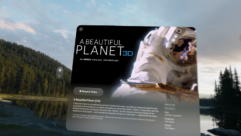

Blinded By 3D
Over-promising and under-delivering. We’ve seen that movie before. Now with clients clamoring for technology that companies insist is ready, are we setting ourselves up for disillusionment?
I’ve always considered Donald Fagen to be one of the prophets of post-modernism. After all, when he recorded “I.G.Y.” in 1982, he was looking back on the promises of modernism and trumpeting its failure. He may have been a bit harsh at the time, because science has delivered some wonderful new solutions. It just hasn’t delivered everything some thought it would and we’re still waking up to the fact it may never solve all our problems.
Now I need to add Thomas Dolby to the list of musical seers. As I walked around InfoComm taking in the sights, I spent as much time as I could looking over 3D technology. And I was reminded of the words from this Dolby song: “It’s poetry in motion/And now she’s making love to me/The spheres are in commotion/The elements in harmony/She blinded me with science/She blinded me with science!/And hit me with technology.”
After visiting various manufacturers, talking to friends who’d sat through classes, and getting seasick (yes, even in the middle of Las Vegas) from watching video through so many active-shutter 3D glasses, I’ve come to the conclusion that we’ve been broadsided by technology. That, and a marketing machine that is promising more than the industry can deliver right now.
Lest you think I’m a complete Luddite, let me assure you: I may not be an early adopter, but I don’t eschew new technology. I just like to see it mature before I recommend it. And, the success of Avatar aside, the technology is not mature yet. Unfortunately, there is a slew of films scheduled to be released in 3D based on Avatar’s success, which will serve to feed the hype machine. Whether they’re as successful depends on a great many things that may well be out of their control.
I applaud James Cameron’s vision, the size of his pocketbook, and the height of his unreasonableness. George Bernard Shaw said, “The reasonable man adapts himself to the world. The unreasonable man persists in trying to adapt the world to himself. Therefore, all progress depends upon the unreasonable man.” Cameron, by dint of his vision, his pocketbook, his obstinacy, and his desire to tell a story using this relatively new technology, will likely be considered a key figure in the development of 3D movie standards. Unfortunately those without such a fortuitous alignment of stars will inevitably take us all one step back.
We’ve been seduced by the marketing juggernaut of Cameron’s studio and the success of one film. This has resulted in clients asking—or even demanding—that 3D imagery be implemented in their facilities. Because as everyone knows, it’s being done right now. Even though there isn’t much content out there. Even though there isn’t a viable economic model for realizing a return on the investment. Even though the standards for production, display, and distribution don’t totally exist yet. Even though it costs more money. Even though …
Beware the Siren Call
But before we get carried away by alluring eyes and cheap perfume, we have a lot of work to do in order to deliver on the promise of 3D. For the immediate future, there is a cry for this technology to be deployed in the residential market. This will set back the industry in much the same way that we were hampered by VHS versus Betamax and the recent standards wars over high-definition DVD.
There are some legitimate uses of 3D in areas such as biomedicine, geology, military, and training and simulation, to name a few. Fortunately, those are industries that share Cameron’s vision, funding, and unreasonableness—the commotion and harmony that Dolby sang winsomely about. Those are markets where useful strides will be made while the entertainment industry sorts out issues surrounding camera construction, depth of field, parallax, encoding, disc manufacture, and a myriad other challenges. In the meantime, we need to educate clients on both the real potential and the real pitfalls.
In the commercial and industrial fields, much of 3D development will be software driven, which will make things easier to control and adjust to create the best user experience. Success in our industries will help feed progress in the entertainment and residential markets instead of the other way around. Vast server farms that are now required to run 3D simulation software and their associated video displays will continue to shrink. Computer algorithms and image quality will improve. Think of video telepresence systems over the past decade. Technology, bandwidth, and the ability to create a system that accounts for human factors has led to a great deal of success. But it’s taken us 40 years to get where we are—and we’re still not entirely where we could be.
In the meantime, let’s be realistic. Instead of over-promising and alienating the public, we need to remind them that progress comes slowly, though it doesn’t always seem that way these days. If we aren’t realistic in our discussions with our clients, we risk turning off another generation to the grand promises of philosophy, art, and science. Who knows? In a few years Donald Fagen could look back on all this and update the lyrics to “I.G.Y.”, reminding us of our foolishness in thinking the future is just around the corner. Or Thomas Dolby could call us to task again for being swayed by another pretty face.










